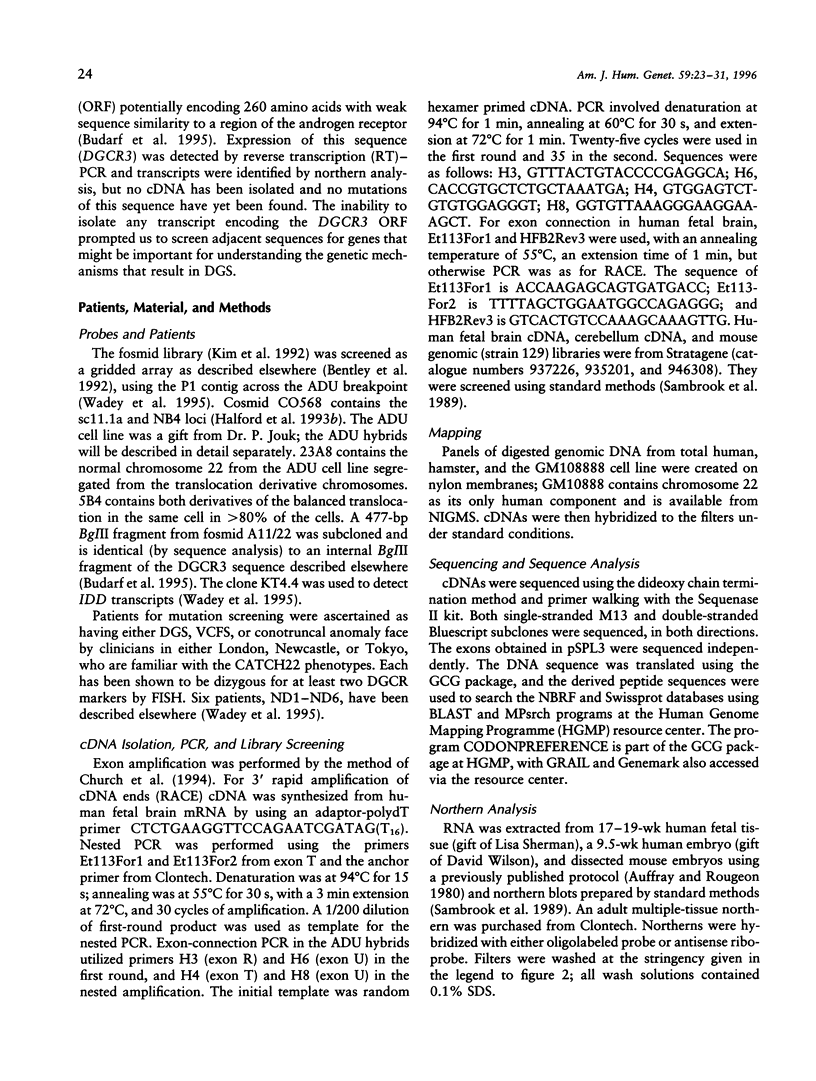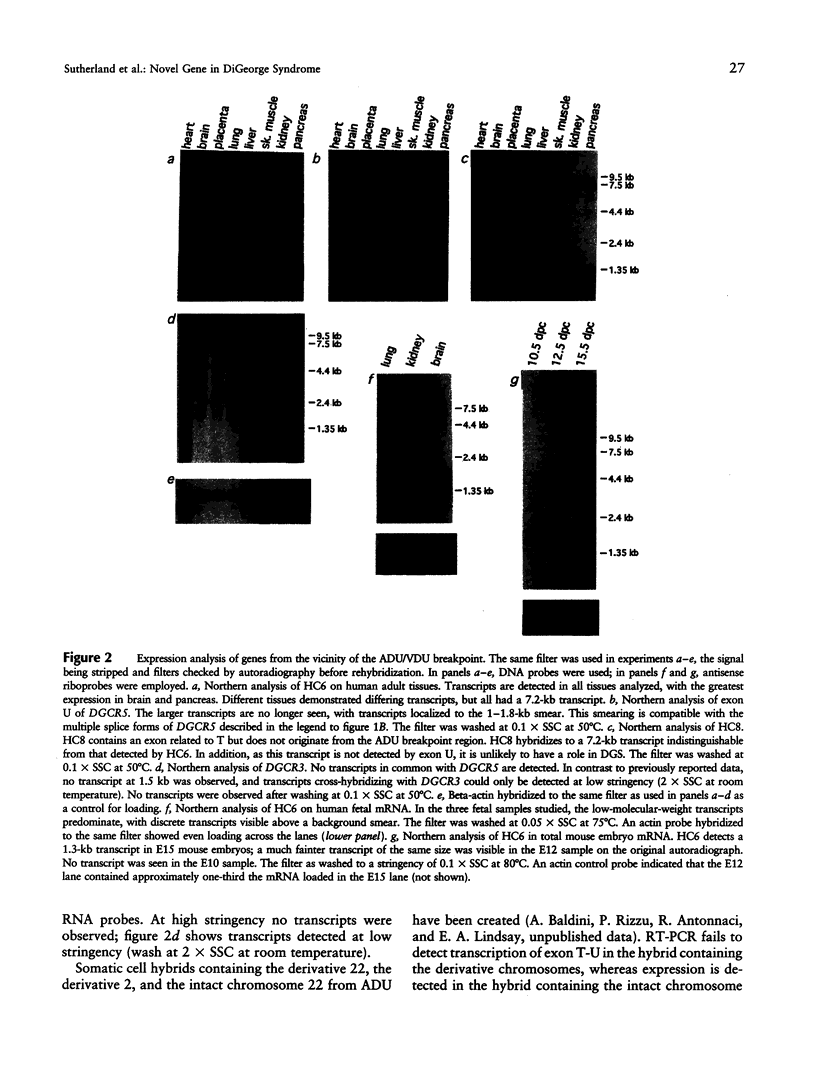Abstract
Most cases of DiGeorge syndrome (DGS) and related abnormalities are associated with deletions within 22q11. Shortest region of deletion overlap (SRO) mapping previously identified a critical region (the DGCR) of 500 kb, which was presumed to contain a gene or genes of major effect in the haploinsufficiency syndromes. The DGCR also contains sequences disrupted by a balanced translocation that is associated with DGS--the ADU breakpoint. We have cloned sequences at the breakpoint and screened for novel genes in its vicinity. A series of alternatively spliced transcripts expressed during human and murine embryogenesis, but with no obvious protein encoding potential, were identified. The gene encoding these RNAs has been named DGCR5 and it is disrupted by the patient ADU breakpoint. DGCR5 is distinct from the DGCR3 open reading frame (ORF) previously shown to be interrupted by the ADU translocation, although DGCR3 is embedded within a DGCR5 intron and in the same (predicted) transcriptional orientation. No mutations of DGCR5 have yet been detected. By analogy to other loci encoding conserved, nontranslated RNAs, it is possible that DGCR5 originates from a cis-acting transcriptional control element in the vicinity of the ADU/VDU breakpoint. Disruption of such an element would result in altered transcription of neighboring genes secondary to a position effect, a hypothesis in keeping with recent refinement of the SRO placing the ADU breakpoint outside the DGCR.
Full text
PDF








Images in this article
Selected References
These references are in PubMed. This may not be the complete list of references from this article.
- Auffray C., Rougeon F. Purification of mouse immunoglobulin heavy-chain messenger RNAs from total myeloma tumor RNA. Eur J Biochem. 1980 Jun;107(2):303–314. doi: 10.1111/j.1432-1033.1980.tb06030.x. [DOI] [PubMed] [Google Scholar]
- Augusseau S., Jouk S., Jalbert P., Prieur M. DiGeorge syndrome and 22q11 rearrangements. Hum Genet. 1986 Oct;74(2):206–206. doi: 10.1007/BF00282098. [DOI] [PubMed] [Google Scholar]
- Brannan C. I., Dees E. C., Ingram R. S., Tilghman S. M. The product of the H19 gene may function as an RNA. Mol Cell Biol. 1990 Jan;10(1):28–36. doi: 10.1128/mcb.10.1.28. [DOI] [PMC free article] [PubMed] [Google Scholar]
- Brown C. J., Hendrich B. D., Rupert J. L., Lafrenière R. G., Xing Y., Lawrence J., Willard H. F. The human XIST gene: analysis of a 17 kb inactive X-specific RNA that contains conserved repeats and is highly localized within the nucleus. Cell. 1992 Oct 30;71(3):527–542. doi: 10.1016/0092-8674(92)90520-m. [DOI] [PubMed] [Google Scholar]
- Budarf M. L., Collins J., Gong W., Roe B., Wang Z., Bailey L. C., Sellinger B., Michaud D., Driscoll D. A., Emanuel B. S. Cloning a balanced translocation associated with DiGeorge syndrome and identification of a disrupted candidate gene. Nat Genet. 1995 Jul;10(3):269–278. doi: 10.1038/ng0795-269. [DOI] [PubMed] [Google Scholar]
- Burn J., Takao A., Wilson D., Cross I., Momma K., Wadey R., Scambler P., Goodship J. Conotruncal anomaly face syndrome is associated with a deletion within chromosome 22q11. J Med Genet. 1993 Oct;30(10):822–824. doi: 10.1136/jmg.30.10.822. [DOI] [PMC free article] [PubMed] [Google Scholar]
- Church D. M., Stotler C. J., Rutter J. L., Murrell J. R., Trofatter J. A., Buckler A. J. Isolation of genes from complex sources of mammalian genomic DNA using exon amplification. Nat Genet. 1994 Jan;6(1):98–105. doi: 10.1038/ng0194-98. [DOI] [PubMed] [Google Scholar]
- Cumberledge S., Zaratzian A., Sakonju S. Characterization of two RNAs transcribed from the cis-regulatory region of the abd-A domain within the Drosophila bithorax complex. Proc Natl Acad Sci U S A. 1990 May;87(9):3259–3263. doi: 10.1073/pnas.87.9.3259. [DOI] [PMC free article] [PubMed] [Google Scholar]
- Demczuk S., Aledo R., Zucman J., Delattre O., Desmaze C., Dauphinot L., Jalbert P., Rouleau G. A., Thomas G., Aurias A. Cloning of a balanced translocation breakpoint in the DiGeorge syndrome critical region and isolation of a novel potential adhesion receptor gene in its vicinity. Hum Mol Genet. 1995 Apr;4(4):551–558. doi: 10.1093/hmg/4.4.551. [DOI] [PubMed] [Google Scholar]
- Driscoll D. A., Budarf M. L., Emanuel B. S. A genetic etiology for DiGeorge syndrome: consistent deletions and microdeletions of 22q11. Am J Hum Genet. 1992 May;50(5):924–933. [PMC free article] [PubMed] [Google Scholar]
- Driscoll D. A., Spinner N. B., Budarf M. L., McDonald-McGinn D. M., Zackai E. H., Goldberg R. B., Shprintzen R. J., Saal H. M., Zonana J., Jones M. C. Deletions and microdeletions of 22q11.2 in velo-cardio-facial syndrome. Am J Med Genet. 1992 Sep 15;44(2):261–268. doi: 10.1002/ajmg.1320440237. [DOI] [PubMed] [Google Scholar]
- Emi M., Horii A., Tomita N., Nishide T., Ogawa M., Mori T., Matsubara K. Overlapping two genes in human DNA: a salivary amylase gene overlaps with a gamma-actin pseudogene that carries an integrated human endogenous retroviral DNA. Gene. 1988;62(2):229–235. doi: 10.1016/0378-1119(88)90561-6. [DOI] [PubMed] [Google Scholar]
- Fantes J., Redeker B., Breen M., Boyle S., Brown J., Fletcher J., Jones S., Bickmore W., Fukushima Y., Mannens M. Aniridia-associated cytogenetic rearrangements suggest that a position effect may cause the mutant phenotype. Hum Mol Genet. 1995 Mar;4(3):415–422. doi: 10.1093/hmg/4.3.415. [DOI] [PubMed] [Google Scholar]
- Foster J. W., Dominguez-Steglich M. A., Guioli S., Kwok C., Weller P. A., Stevanović M., Weissenbach J., Mansour S., Young I. D., Goodfellow P. N. Campomelic dysplasia and autosomal sex reversal caused by mutations in an SRY-related gene. Nature. 1994 Dec 8;372(6506):525–530. doi: 10.1038/372525a0. [DOI] [PubMed] [Google Scholar]
- Giannotti A., Digilio M. C., Marino B., Mingarelli R., Dallapiccola B. Cayler cardiofacial syndrome and del 22q11: part of the CATCH22 phenotype. Am J Med Genet. 1994 Nov 15;53(3):303–304. doi: 10.1002/ajmg.1320530320. [DOI] [PubMed] [Google Scholar]
- Halford S., Lindsay E., Nayudu M., Carey A. H., Baldini A., Scambler P. J. Low-copy-number repeat sequences flank the DiGeorge/velo-cardio-facial syndrome loci at 22q11. Hum Mol Genet. 1993 Feb;2(2):191–196. doi: 10.1093/hmg/2.2.191. [DOI] [PubMed] [Google Scholar]
- Halford S., Wadey R., Roberts C., Daw S. C., Whiting J. A., O'Donnell H., Dunham I., Bentley D., Lindsay E., Baldini A. Isolation of a putative transcriptional regulator from the region of 22q11 deleted in DiGeorge syndrome, Shprintzen syndrome and familial congenital heart disease. Hum Mol Genet. 1993 Dec;2(12):2099–2107. doi: 10.1093/hmg/2.12.2099. [DOI] [PubMed] [Google Scholar]
- Hogan N. C., Traverse K. L., Sullivan D. E., Pardue M. L. The nucleus-limited Hsr-omega-n transcript is a polyadenylated RNA with a regulated intranuclear turnover. J Cell Biol. 1994 Apr;125(1):21–30. doi: 10.1083/jcb.125.1.21. [DOI] [PMC free article] [PubMed] [Google Scholar]
- Karayiorgou M., Morris M. A., Morrow B., Shprintzen R. J., Goldberg R., Borrow J., Gos A., Nestadt G., Wolyniec P. S., Lasseter V. K. Schizophrenia susceptibility associated with interstitial deletions of chromosome 22q11. Proc Natl Acad Sci U S A. 1995 Aug 15;92(17):7612–7616. doi: 10.1073/pnas.92.17.7612. [DOI] [PMC free article] [PubMed] [Google Scholar]
- Kim U. J., Shizuya H., de Jong P. J., Birren B., Simon M. I. Stable propagation of cosmid sized human DNA inserts in an F factor based vector. Nucleic Acids Res. 1992 Mar 11;20(5):1083–1085. doi: 10.1093/nar/20.5.1083. [DOI] [PMC free article] [PubMed] [Google Scholar]
- Leighton P. A., Ingram R. S., Eggenschwiler J., Efstratiadis A., Tilghman S. M. Disruption of imprinting caused by deletion of the H19 gene region in mice. Nature. 1995 May 4;375(6526):34–39. doi: 10.1038/375034a0. [DOI] [PubMed] [Google Scholar]
- Levy A., Demczuk S., Aurias A., Depétris D., Mattei M. G., Philip N. Interstitial 22q11 microdeletion excluding the ADU breakpoint in a patient with DiGeorge syndrome. Hum Mol Genet. 1995 Dec;4(12):2417–2419. doi: 10.1093/hmg/4.12.2417. [DOI] [PubMed] [Google Scholar]
- Lindsay E. A., Halford S., Wadey R., Scambler P. J., Baldini A. Molecular cytogenetic characterization of the DiGeorge syndrome region using fluorescence in situ hybridization. Genomics. 1993 Aug;17(2):403–407. doi: 10.1006/geno.1993.1339. [DOI] [PubMed] [Google Scholar]
- Lipshitz H. D., Peattie D. A., Hogness D. S. Novel transcripts from the Ultrabithorax domain of the bithorax complex. Genes Dev. 1987 May;1(3):307–322. doi: 10.1101/gad.1.3.307. [DOI] [PubMed] [Google Scholar]
- McDonald-McGinn D. M., Driscoll D. A., Bason L., Christensen K., Lynch D., Sullivan K., Canning D., Zavod W., Quinn N., Rome J. Autosomal dominant "Opitz" GBBB syndrome due to a 22q11.2 deletion. Am J Med Genet. 1995 Oct 23;59(1):103–113. doi: 10.1002/ajmg.1320590122. [DOI] [PubMed] [Google Scholar]
- Ninomiya S., Isomura M., Narahara K., Seino Y., Nakamura Y. Isolation of a testis-specific cDNA on chromosome 17q from a region adjacent to the breakpoint of t(12;17) observed in a patient with acampomelic campomelic dysplasia and sex reversal. Hum Mol Genet. 1996 Jan;5(1):69–72. doi: 10.1093/hmg/5.1.69. [DOI] [PubMed] [Google Scholar]
- Ravnik-Glavac M., Glavac D., Dean M. Sensitivity of single-strand conformation polymorphism and heteroduplex method for mutation detection in the cystic fibrosis gene. Hum Mol Genet. 1994 May;3(5):801–807. doi: 10.1093/hmg/3.5.801. [DOI] [PubMed] [Google Scholar]
- Sargent C. A., Chalmers I. J., Leversha M., Affara N. A. A rearrangement on chromosome 5 of an expressed human beta-glucuronidase pseudogene. Mamm Genome. 1994 Dec;5(12):791–796. doi: 10.1007/BF00292015. [DOI] [PubMed] [Google Scholar]
- Scambler P. J., Carey A. H., Wyse R. K., Roach S., Dumanski J. P., Nordenskjold M., Williamson R. Microdeletions within 22q11 associated with sporadic and familial DiGeorge syndrome. Genomics. 1991 May;10(1):201–206. doi: 10.1016/0888-7543(91)90501-5. [DOI] [PubMed] [Google Scholar]
- Scambler P. J., Kelly D., Lindsay E., Williamson R., Goldberg R., Shprintzen R., Wilson D. I., Goodship J. A., Cross I. E., Burn J. Velo-cardio-facial syndrome associated with chromosome 22 deletions encompassing the DiGeorge locus. Lancet. 1992 May 9;339(8802):1138–1139. doi: 10.1016/0140-6736(92)90734-k. [DOI] [PubMed] [Google Scholar]
- Wadey R., Daw S., Taylor C., Atif U., Kamath S., Halford S., O'Donnell H., Wilson D., Goodship J., Burn J. Isolation of a gene encoding an integral membrane protein from the vicinity of a balanced translocation breakpoint associated with DiGeorge syndrome. Hum Mol Genet. 1995 Jun;4(6):1027–1033. doi: 10.1093/hmg/4.6.1027. [DOI] [PubMed] [Google Scholar]
- Wagner T., Wirth J., Meyer J., Zabel B., Held M., Zimmer J., Pasantes J., Bricarelli F. D., Keutel J., Hustert E. Autosomal sex reversal and campomelic dysplasia are caused by mutations in and around the SRY-related gene SOX9. Cell. 1994 Dec 16;79(6):1111–1120. doi: 10.1016/0092-8674(94)90041-8. [DOI] [PubMed] [Google Scholar]
- Watanabe Y., Yamamoto M. S. pombe mei2+ encodes an RNA-binding protein essential for premeiotic DNA synthesis and meiosis I, which cooperates with a novel RNA species meiRNA. Cell. 1994 Aug 12;78(3):487–498. doi: 10.1016/0092-8674(94)90426-x. [DOI] [PubMed] [Google Scholar]
- Wevrick R., Kerns J. A., Francke U. Identification of a novel paternally expressed gene in the Prader-Willi syndrome region. Hum Mol Genet. 1994 Oct;3(10):1877–1882. doi: 10.1093/hmg/3.10.1877. [DOI] [PubMed] [Google Scholar]
- Wilson D. I., Burn J., Scambler P., Goodship J. DiGeorge syndrome: part of CATCH 22. J Med Genet. 1993 Oct;30(10):852–856. doi: 10.1136/jmg.30.10.852. [DOI] [PMC free article] [PubMed] [Google Scholar]




